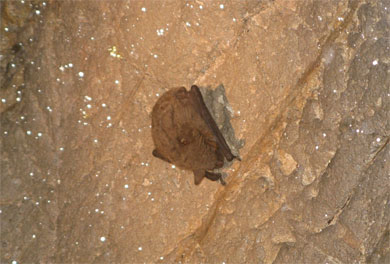Myotis adversus
Large-footed Myotis; Southern Myotis
Morphological description Life history Distribution Habitat Roost sites and roosting patterns Emergence and flight pattern Foraging behaviour Echolocation calls Status and protection

Morphological Description
· Dorsal fur is dark grey. Ventral fur is lighter than dorsal fur.
· Juveniles are lighter than adults.
· This is a medium-sized bat in China. Body length mm, tail length mm. Average forearm length -mm. Average wingspan is 28 cm.
· The feet are large, more than 8 mm in length, with curved claws.
· The weight is up to 15 g.
Life history
· Little known
Distribution
The mainland Chinese distribution is shown by dots on the map (as given by Zhang et al. (1997)). We have new records for this species in Shandong and Fujian Province in 2006 and 2007. Identification was made by matching gene sequences with those for this species in GenBank. Bats formerly described as this species in Australia are now referred to M. macropus.

Habitat
· Water areas such as streams, lakes, ponds, and rivers are important for this species.
Roost sites and roosting behaviour
· Roost is caves.
· Also, it can be found in buildings, mine shafts, hollow trees.
· This species may share their roosts with other bat species. In Shandong Province , we found this bat roosting with Rhinolophus pusillus and other myotis species.
Emergence and flight pattern
· Little known.
Foraging behaviour
· Forages at low-medium heights in woodland and over water.
· The diet mainly probably consists of insects and maybe includes small fishes.Echolocation calls
· Unknown.
Status and protection
· There is no estimation of population size for China.
· Large-footed myotis bats are at LR/lc, assessed by the Red List of Threatened Species (IUCN, 2007) and are not listed in the Law of the People's Republic of China on the Protection of Wildlife in 1989.
· Caves and woodland as well as water regions should be protected as their habitats.